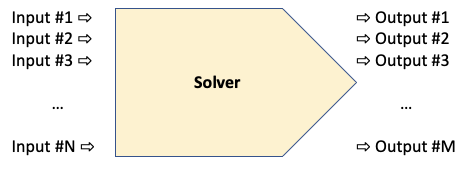Description of a System behavior in response to the parameters to which the system is sensitive to (see Fig. 1).
Modern Models are usually implemented in the form of a computer software which provides interface to:
| Supply the Model Inputs | → | Initiate a Model Run | → | Retrieve the Model Outputs |
|---|
| Fig. 1. Schematic of Model's components, including Model Inputs, Model Outputs and Model Solver |
It normally follows the Model Description Protocol:
| Motivation | Explains the reasons why a Model may come in need |
|---|---|
| Inputs | A list of System properties which Model takes as input |
| Outputs | A list of System properties which Model simulates based on the Model Inputs |
| Model Proposition | A list of assumptions/constraints which have been put into the Model |
| Model Mathematics | Definition of the Model using mathematical concepts and mathematical language |
| Model Solver | Description of the solution algorithm to the Mathematical Model |
| Approximations | Simplified solver(s) for rough estimations and fast track analysis of a System's behavior |
| Model Matching | Description of algorithm of matching the Model to the training data |
| Applications | A list of popular Model applications and limitations |
| Examples (Cases) | A list of practical cases showing Model functionality and usefulness and limitations |
A System may have many Models depending on which System properties are taken as Model Inputs and Model Outputs.
The Model may have some governing properties which can be trained to make Model output fit the experimental data.
The results of the training should be qualified by means of Model Validation.
See also
Human / Science / Formal Science / System Science
[ Model Solver ][ Model Run ][ Model Validation ][ Model Matching ]
[ Mathematics ][ Analytical Model ][ Numerical Model ]
